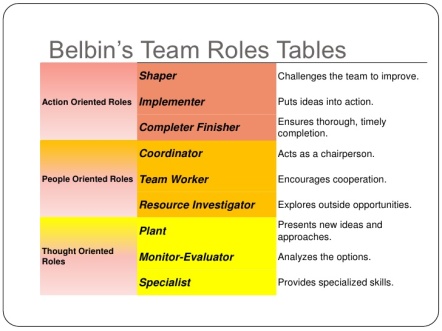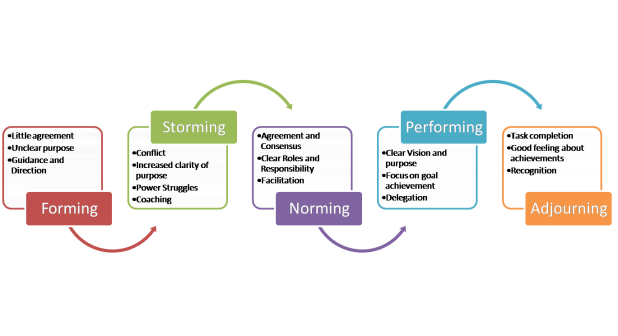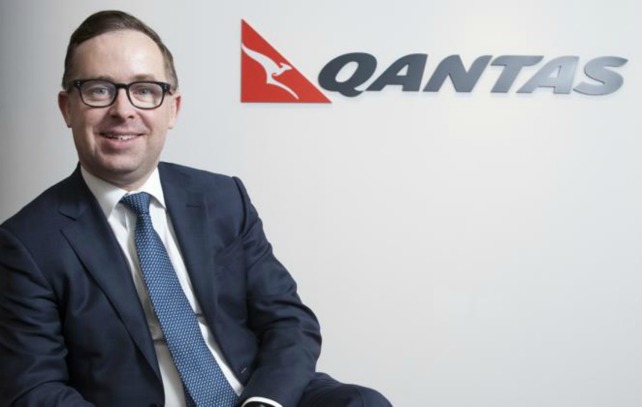Diversity in a workplace nowadays can include a lot more categories that race, culture, and gender: religion affiliation, sexual orientation, generation, disability, personality, and the diversity of thought (Aperian Global 2015). Research actually shows that the levels of innovation and competitiveness in companies have a positive correlation with how they embrace diversity (breakingthemold.openmic.org 2017). As Belbin’s Roles Theory suggested, most successful teams were made up of a diverse mix of behaviours, all of them with certain strengths and weaknesses that compliment each other, as explained in the following table.
 Belbin’s Team Roles Table (Slideshare)
Belbin’s Team Roles Table (Slideshare)
In Tuckman and Jensen’s model (1977), 5 stages of team development were identified: forming, storming, norming, performing, and adjourning. Diversity plays a big role in the storming stage. The presence of diversity in thinking or informational processing would largely result in “constructive conflict, or debate, around the task at hand … people [would] deliberate about the best course of action” (Stanford Graduate School of Business 1999).
 Tuckman & Jensen 5 Stages Model (margarethillary.com)
Tuckman & Jensen 5 Stages Model (margarethillary.com)
However, one major concern and limitation of this view is that a lot of attention was given to the advantages it can bring for the business that it actually overshadows the moral, social, and ethical issues of treating people equally (Mullins 2010: 160). This could result in economic reasons being the major or sole drive for promoting diversity. Having team members from diverse cultural, educational, and demographical backgrounds also gives more opportunity for more variative conflicts to arise. Old ways of thinking and stereotypical prejudices may create unnecessary tension and conflict. There may also be additional financial costs associated with diversity such as the need for gender neutral bathroom (for transgenders), roll-in toilets (for people with disability), lactation room (for breastfeeding ladies), prayer room (for Muslim colleagues), and many others (London 2016).
Another problem would be to make sure there is an effective communication throughout the team. As cultures collide, misinterpretations and miscommunications would be present form time to time. Diverse team members would have different working styles, etiquette, and attitude with them; reflecting their own cultural values and differences. Failing to communicate effectively and give equal platform for all of the differing views would cause a dynamic problem within the team itself. A great example of this is the difference between how a Japanese and an American would handle other people’s business cards. Business card etiquette is very important protocol in Japan that it would be considered rude not to present one with both hands during a business meeting. The card must then be presented in full view throughout the entire meeting as not to offend the giver and no writing is to be done on the card itself (Chaves 2017). In America, a polite exchange of business cards is still procedural but most people, especially those working in digital advertising or IT, will gladly provide you their LinkedIn profile or a handwritten note with their name and phone number on it.
The need of strong and effective leadership
Alan Joyce, CEO of Qantas Australia, is a champion of diversity management. The openly gay CEO often talks about how it helps the airline get back on its feet. In 2011, public loathed him when he decided to restructure the whole company and laid down 5,000 jobs. In 2016, Qantas managed to deliver the best half-profit ever in its 95 years history. When people asked him how he did it, Joyce said, [Diversity] got us through the tough times . . . Diversity generated better strategy, better risk management, better debates, [and] better outcomes” (Hewett 2016).
 Alan Joyce, CEO (Qantas)
Alan Joyce, CEO (Qantas)
Conclusion
An understanding of diversity requires a change of culture into something that both respects individual differences and at the same time treats all team members with respect. Diversity is crucial because it provides room for innovation and adaptation within an organisation in this world of fast-changing environment (Walter 2014), resulting in both competitive advantage and economic success (Hewlett et al. 2012). In this context, leaders play a crucial role in managing diversity, they need to “bring together people of different ethnic backgrounds, religions, gender and age groups into cohesive and productive organizational units” (Armstrong 2009) which is not an easy task. Diversity also comes with its own set of disadvantages, so leaders need to formulate and implement rules and policies to maximise its advantages while at the same time minimize the potential conflicts. They would also need to consistently apply values of fairness and equality and lead by their own example. The strength of diverse team is best summarised by Stephen Covey, the author of The 7 Habits of Highly Effective People, with his quote, “Strength lies in differences, not in similarities.”.
773 words (with citation)
References
Aperian Global. (2015) Diversity & Inclusion: 5 Lessons from Top Global Companies. [online] available from <http://www.aperianglobal.com/leaders-diversity-inclusion-5-lessons-top-global-companies/> [9 Feb. 2018].
Armstrong, M. (2016) Armstrong’s Handbook of Management and Leadership for HR. 4th ed. Philadelphia: Kogan Page, pp.260-263.
Breakingthemold.openmic.org. (2017) BREAKING THE MOLD – Investing in Racial Diversity in Tech. [online] available from <http://breakingthemold.openmic.org/> [10 Feb. 2018].
Chaves, E. (2017) Business cards in Japan: So many rules, so easily and often broken. [online] available from <https://www.japantimes.co.jp/community/2017/10/29/our-lives/business-cards-japan-many-rules-easily-often-broken/#.WpOpi6hubIV> [11 Feb. 2018]
Covey, S. (2018) A quote by Stephen R. Covey. [online] available from <https://www.goodreads.com/quotes/68074-strength-lies-in-differences-not-in-similarities> [12 Feb. 2018].
Hewett, J. (2016) Beyond Joyce’s ‘darkest moment’. The Australian. [online] available from <https://www.theaustralian.com.au/business/in-depth/perpetual/alan-joyce-says-management-diversity-was-key-to-getting-qantas-through-turbulent-times/news-story/5afe123042f7d2e20b8d3a5f001477b8> [10 Feb. 2018].
Hewlett, S., Jackson, M., Cose, E. and Emerson, C. (2012) Vaulting the Colour Bar: How Sponsorship Levers Multicultural Professionals into Leadership. New York: Center for Talent Innovation.
Hult News (2017) 13 benefits and challenges of cultural diversity in the workplace in 2017. [online] available from <http://www.hult.edu/blog/benefits-challenges-cultural-diversity-workplace/> [10 Feb. 2018]
Ibarra, H. & Hansen, M. (2011) ‘Are You a Collaborative Leader?’, Harvard Business Review, 89, 7/8, pp. 68-74, Business Source Complete, EBSCOhost.
London, J. (2016). Let’s Talk About Bathrooms [online] available from <https://www.diversitybestpractices.com/news-articles/lets-talk-about-bathrooms> [10 Feb.2018]
Mullins, L. (2010). Management and organisational behaviour. 9th ed. Essex: Pearson Education Limited, p.160.
Stanford Graduate School of Business. (1999). Diversity and Work Group Performance. [online] available from <https://www.gsb.stanford.edu/insights/diversity-work-group-performance> [9 Feb. 2018].
Walter, E. (2014). Forbes Welcome. [online] available from <https://www.forbes.com/sites/ekaterinawalter/2014/01/14/reaping-the-benefits-of-diversity-for-modern-business-innovation/#67b614402a8f> [10 Feb. 2018].
“Diversity promotes complexity”
Do you see this an advantage to the organisation?Why?
LikeLike
To a certain extent, yes. Even without diversity, complexity is naturally occuring with growth of both the organisation and the number of team members. What diversity does, inline with promoting complexity, is also promoting creativity, debates, and innovation; leading to better decision making and solutions. So yes, complexity is a necessary devil for growth. Hope this answers your question.
LikeLike
I agreed with you that managing diversity is not an easy task. Yet many multinational companies are paying lots of attention to workplace diversity. What are the attributes do you think that lead to a success in diversity management?
LikeLike
It is true that companies nowadays pay lots of attention to achieving diversity, sadly they are mainly due to its economical benefits and not because it is the morally right thing to do, which I highlighted as a limitation in the article. I believe there are a few important steps you need for good diversity management:
1. D&I training for all levels of employees
2. Getting rid of stereotyping – lead by example in this
3. Patience – it takes time for people to wotk together well, especially if they all come from different backgrounds. Diversity management will only show its benefits after some time so keep in mind that the goal is a long-term one.
LikeLike
Hi Febrinal, you had clearly shown the advantages of having a diverse team. In your opinion, what are the personal attribute or traits that a leader should consider when forming a team?
LikeLike
Hi Khong, in order for a team to be effective, diversity itself is often not enough. There are a few things I would consider in forming a team:
1. Capabilities and trustworthiness – coming from different backgrounds is not a problem as long as team members have this among themselves, trust. Trusting the leader’s vision, trusting and respecting each other’ judgement, and trust that their voices would be heard.
2. Common goals – willingness to forgo personal goals to achieve a common one, without a common vision and goal, no team can work effectively in unison.
3. Collaborative abilities – open lines of communication, ability to work together, capacity to give and receive objective constructive criticisms.
There may be more, but these are the ones I feel strongly about. Feel free to add your opinion! 🙂
LikeLike
The blog covers up a very detailed explanation of team diversity and also stating some real-life examples of cultural differences. It is excellent! Do you think that being emotionally intelligent will ease the process of managing a diverse team?
LikeLike
Haha thanks Jia Seng. I have always been an avid believer of EQ’s importance, not just in working environment but also in daily social life. Having a high EQ will definitely help a leader to get the team to work together. However, in face of diversity, EQ itself is not enough, a practice of Diversity Inclusion (D&I) is also needed. This is because everyone has an unconscious bias, which leads us to be more comfortable with certain group of people over another. This is not wrong by itself, but ideally with D&I training, the effect of this in a leader’s decision-making ability should be minimised, granting every team member fair and equal chance based on their performances.
LikeLike
Do you think it is easier to manage a diverse team in the Asian culture, compared to the western culture?
LikeLike
Thanks for reading Kathy. From my own personal experience, no it will not be easier to manage a diverse team in the Asian culture. While it may look easier to manage since Asian tend to hold their personal opinion instead of speaking up against their leaders, but the unconscious bias to work with people similar to them is present everywhere. It is a common sight to see certain ethnic group huddled together and only hanging out with their own kind. Westerners tend to be more individualistic in their approach, which may translate into more flexibility in their cultural bias. However, this personal view is only based on my limited experience, I hope it helps.
LikeLike
Your blog got valuable information.
It’s not really possible to master all the cultures in a international organization, by keeping this in mind, is there any way to act accordingly to meet everyone’s expectations?
LikeLike
Thanks Mohammad. There are a few steps to handle this:
1. Prioritize communication: Effective communication for policies, procedures, safety rules and other important information, they must be designed to overcome language and cultural barriers by translation or the use of images and diagrams.
2. Treat people as individual: Not basing judgement on prejudice of their cultural background.
3. Be objective: Have the same standard for different criteria and make sure everyone is treated equally.
4. Lastly, be open minded: It is only natural that different people have different adaptability levels. Be understanding and fair to every member of the team.
Managing diversity is basically making sure that communication between team members can flow effectively and everyone is treated equally regardless of their backgrounds or physical difference.
LikeLike